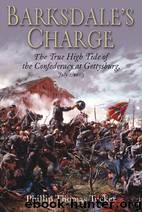Barksdale's Charge by Phillip Thomas Tucker

Author:Phillip Thomas Tucker
Language: eng
Format: epub
Tags: HISTORY / Military / Aviation
Publisher: Casemate
Published: 2013-07-23T16:00:00+00:00
Map courtesy of Bradley M. Gottfried
“The guiding spirit of the battle”
MEANWHILE, BARKSDALE CONTINUED to lead the 13th, 17th, and 18th Mississippi northeast up the Emmitsburg Road, smashing resistance in the open fields to its east. After hurling aside the New Yorkers of the Second Brigade of Humphreys’ Division, Third Corps, the attacking soldiers surged onward to threaten additional units on the exposed left flank of General Joseph B. Carr’s First Brigade, Second Division. Union General Humphreys described Barksdale’s gains: “My infantry now engaged the enemy’s, but my left was in air … and being the only troops on the field, the enemy’s whole attention was directed to my division, which was forced back.” Humphreys realized that he had “never been under a hotter fire of musketry and artillery combined [and] for the moment I thought the day was lost.”
To the onrushing Mississippians, this fight was turning into a turkeyshoot, with the yelping Rebels loading and firing on the run as rapidly as possible. Crossing the east-west running Abraham Trostle Lane that led over the fields descending down to Trostle’s house and barn in Plum Run’s valley, they continued to charge onward with wild shouts. Despite the heavy losses and his men’s exertions, Barksdale still refused to halt the troops to either reload or rest with so many Federals on the run, and the left of Carr’s brigade giving way under the relentless pressure. No time, not a minute, could be wasted, if decisive victory was to be gained before the sun went down. During his sweeping attack along the Emmitsburg Road, Barksdale not only continued to inflict punishment on the vulnerable left flanks of additional Federal units aligned parallel to the road, but also on steadily retiring, but stubborn, Union regiments which had already been hurled out of the Peach Orchard.
With his regiment cut to pieces after losing nearly half of its numbers in tangling with the Mississippians today, Captain Edward R. Bowen, now commanding what little was left of the 114th Pennsylvania, continued to withdraw before Barksdale’s onslaught: “All this time we were being hotly followed by the enemy, and very close they were to us, our main endeavor being to get our colors safely off … what remained of the regiment, amounting altogether to not much more than a color guard, faced to the enemy and fired … the masses of the enemy were almost on them. We left the Emmitsburg road covered with our dead and wounded.” As the final insult, at least one Mississippi officer now led his elated troops northeast with a captured Zouave fez on his head: a trophy that inspired his jubilant troops in their steamrolling attack.371
With many Magnolia State officers already shot down, surviving leaders rose to the fore during the swirling combat. A 27-year-old farmer from Early Grove in north-central Mississippi was one such resilient leader. Lieutenant James, or “Jim,” Ramsuer was hit when a lead ball tore through the fleshy part of his cheek and mouth, barely missing bone and teeth.
Download
This site does not store any files on its server. We only index and link to content provided by other sites. Please contact the content providers to delete copyright contents if any and email us, we'll remove relevant links or contents immediately.
| African Americans | Civil War |
| Colonial Period | Immigrants |
| Revolution & Founding | State & Local |
Cat's cradle by Kurt Vonnegut(13862)
Pimp by Iceberg Slim(12929)
Underground: A Human History of the Worlds Beneath Our Feet by Will Hunt(11256)
4 3 2 1: A Novel by Paul Auster(11045)
The Radium Girls by Kate Moore(10906)
American History Stories, Volume III (Yesterday's Classics) by Pratt Mara L(4824)
Perfect Rhythm by Jae(4621)
Wiseguy by Nicholas Pileggi(4585)
The Fire Next Time by James Baldwin(4341)
Paper Towns by Green John(4169)
A Higher Loyalty: Truth, Lies, and Leadership by James Comey(4031)
Pale Blue Dot by Carl Sagan(4001)
The Mayflower and the Pilgrims' New World by Nathaniel Philbrick(3910)
The Doomsday Machine by Daniel Ellsberg(3730)
Too Much and Not the Mood by Durga Chew-Bose(3693)
Killers of the Flower Moon: The Osage Murders and the Birth of the FBI by David Grann(3608)
The Borden Murders by Sarah Miller(3588)
The Sympathizer by Viet Thanh Nguyen(3477)
Killing England by Bill O'Reilly(3454)
